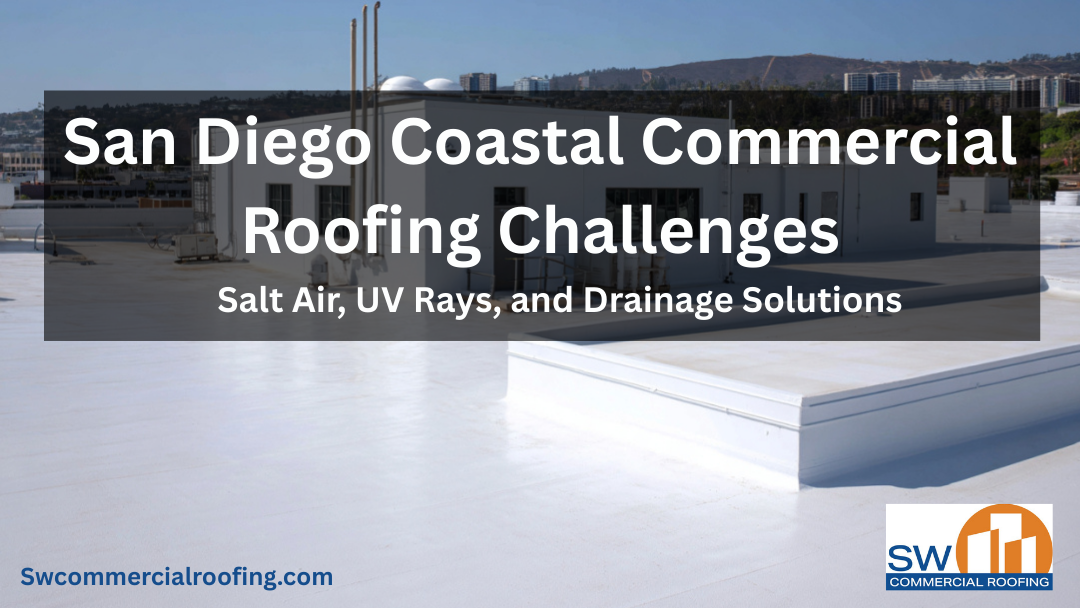San Diego Coastal Commercial Roofing Challenges: Salt Air, UV Rays, and Drainage Solutions
San Diego is known for its stunning coastline, mild year-round temperatures, and nearly endless sunshine. While these conditions make the city a great place to live and do business, they also create unique challenges for commercial roofing systems. Property owners and managers along the coast face a constant battle against elements that may not be obvious at first glance but can dramatically shorten the life of a roof if left unaddressed.
Unlike inland areas, San Diego buildings must contend with the triple threat of salt air, intense UV exposure, and seasonal rainfalls. Each of these factors accelerates roof wear in different ways: salty ocean breezes corrode metal and degrade membranes, UV rays break down roofing materials under constant sunlight, and heavy rains test the limits of flat-roof drainage systems. Together, they create an environment where even high-quality roofs require extra care and planning.
For business owners, ignoring these issues can lead to higher energy costs, leaks, safety concerns, and expensive premature replacements. The good news is that with the right materials, design strategies, and maintenance plans, your roof can withstand San Diego’s coastal conditions and deliver lasting performance.
In this article, we’ll take a closer look at the three biggest roofing challenges in San Diego—salt air, UV rays, and drainage—and explore proven solutions to protect your investment.
Challenge #1: Salt Air Corrosion
One of the most underestimated threats to commercial roofs in San Diego is salt air corrosion. While the ocean provides a beautiful backdrop for businesses along the coast, the salty breeze carries microscopic particles that settle on building surfaces, including rooftops. Over time, these particles act like an abrasive agent, wearing down materials much faster than in inland locations.
How Salt Air Affects Different Roofing Materials
- Metal Roofs: Salt accelerates rust and pitting, especially on untreated or poorly coated steel. Even galvanized and aluminum roofs, though more resistant, can suffer gradual deterioration without proper protection.
- Single-Ply Membranes (TPO, PVC, EPDM): Salt particles embed into the membrane surface, breaking down its chemical structure. Over years, this can cause brittleness and premature cracking.
- Roof Accessories: HVAC units, vents, and flashing made from metal are equally vulnerable. These components often fail first, leading to leaks around penetrations.
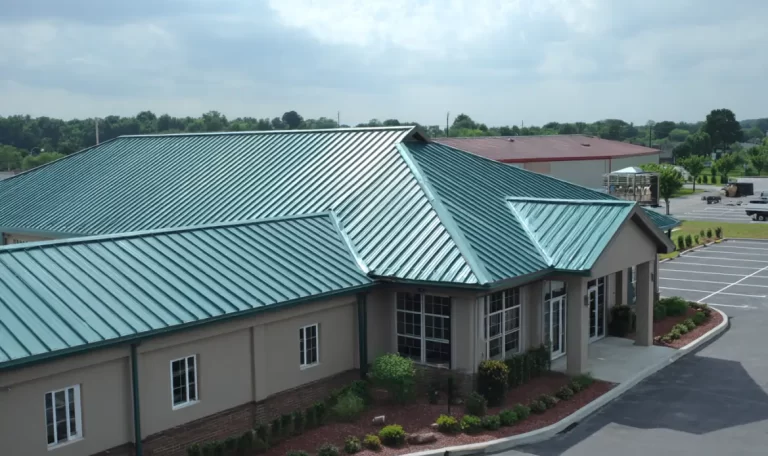
Real-World Impact on San Diego Properties
Consider a coastal hotel or beachfront retail complex: exposure to constant ocean breezes means roofing systems face a near-daily assault of salt-laden moisture. Without adequate protection, property managers may see significant deterioration in as little as 5–7 years—much sooner than the expected 15–25 years for well-maintained roofs inland.
The financial cost of salt air corrosion isn’t just in roof replacement. Leaks can damage insulation, interior walls, and expensive equipment, leading to unexpected operational downtime.
Solutions to Combat Salt Air Corrosion
The good news is that proactive strategies can significantly reduce the impact of salt air on roofing systems:
- Material Selection: Choose roofing membranes that are resistant to chemical degradation, such as PVC or high-quality TPO. For metal roofing, opt for aluminum or coated steel with marine-grade finishes.
- Protective Coatings: Specialized coatings act as a barrier between the roof surface and salt particles, slowing down the corrosive process. These can be reapplied as part of routine maintenance.
- Routine Inspections: Buildings within a few miles of the coast should schedule inspections at least twice a year. Professionals can identify early signs of corrosion and recommend timely interventions.
- Regular Cleaning: Simple but effective—washing down the roof periodically removes salt deposits before they can accumulate and cause damage.
Why It Matters
Salt air corrosion is not a challenge you can ignore. By investing in the right materials and maintenance practices, San Diego property owners can extend roof lifespans, avoid costly structural repairs, and ensure their buildings remain protected against one of the coast’s most persistent threats.
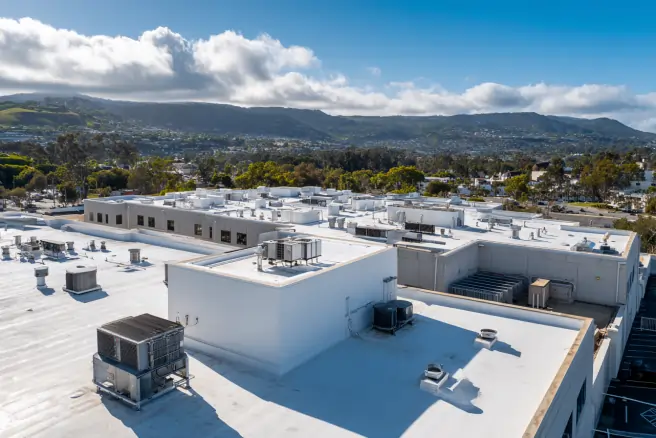
Challenge #2: Intense UV Exposure
San Diego is famous for its year-round sunshine, boasting more than 260 sunny days annually. While this is great for tourism and outdoor lifestyles, the constant UV (ultraviolet) exposure creates a harsh environment for commercial roofing systems. Unlike areas with more cloud cover or seasonal variation, San Diego’s consistent sunshine means that commercial roofs rarely get a break from the sun’s rays.
How UV Rays Damage Roofing Materials
- Single-Ply Membranes (TPO, PVC, EPDM): UV radiation gradually breaks down the chemical bonds within these membranes, causing them to dry out, shrink, and crack. Once cracks form, leaks are only a matter of time.
- Asphalt-Based Roofs (Modified Bitumen): These roofs can soften and blister under intense heat, losing their waterproofing effectiveness.
- Coatings and Sealants: UV exposure degrades many protective coatings, meaning they must be reapplied periodically to remain effective.
Over time, these effects lead to reduced flexibility, surface erosion, and eventually water intrusion—shortening the expected lifespan of even the best roofing systems.
The Cost of UV-Related Damage
Beyond structural issues, UV degradation also has energy cost implications. As roofing materials break down, they lose reflectivity, meaning buildings absorb more heat. This forces HVAC systems to work harder, driving up cooling costs—especially during peak summer months. In San Diego, where air conditioning is a year-round necessity for many businesses, this translates directly into higher operating expenses.
Proven Solutions to Combat UV Damage
- Reflective Roofing Materials: Installing reflective systems such as white TPO or PVC membranes can significantly reduce UV absorption and lower cooling costs.
- Cool Roof Coatings: Applying elastomeric or reflective coatings provides an additional layer of UV protection and helps maintain energy efficiency.
- Proper Insulation: A well-insulated roofing system reduces thermal stress caused by expansion and contraction, minimizing UV-related cracking.
- Scheduled Maintenance: Regular inspections ensure that minor UV damage (like small cracks or surface wear) is addressed early before it develops into leaks.
Why San Diego Businesses Should Act Now
With San Diego’s climate, UV exposure is not a seasonal challenge—it’s a year-round reality. Business owners who fail to address UV damage often face premature roof replacement, escalating cooling costs, and unexpected disruptions to operations.
By investing in reflective materials, protective coatings, and proactive maintenance, commercial property owners can extend the life of their roofs while simultaneously improving energy efficiency. Over time, these measures don’t just protect the building—they also pay for themselves in lower utility bills and fewer repair costs.
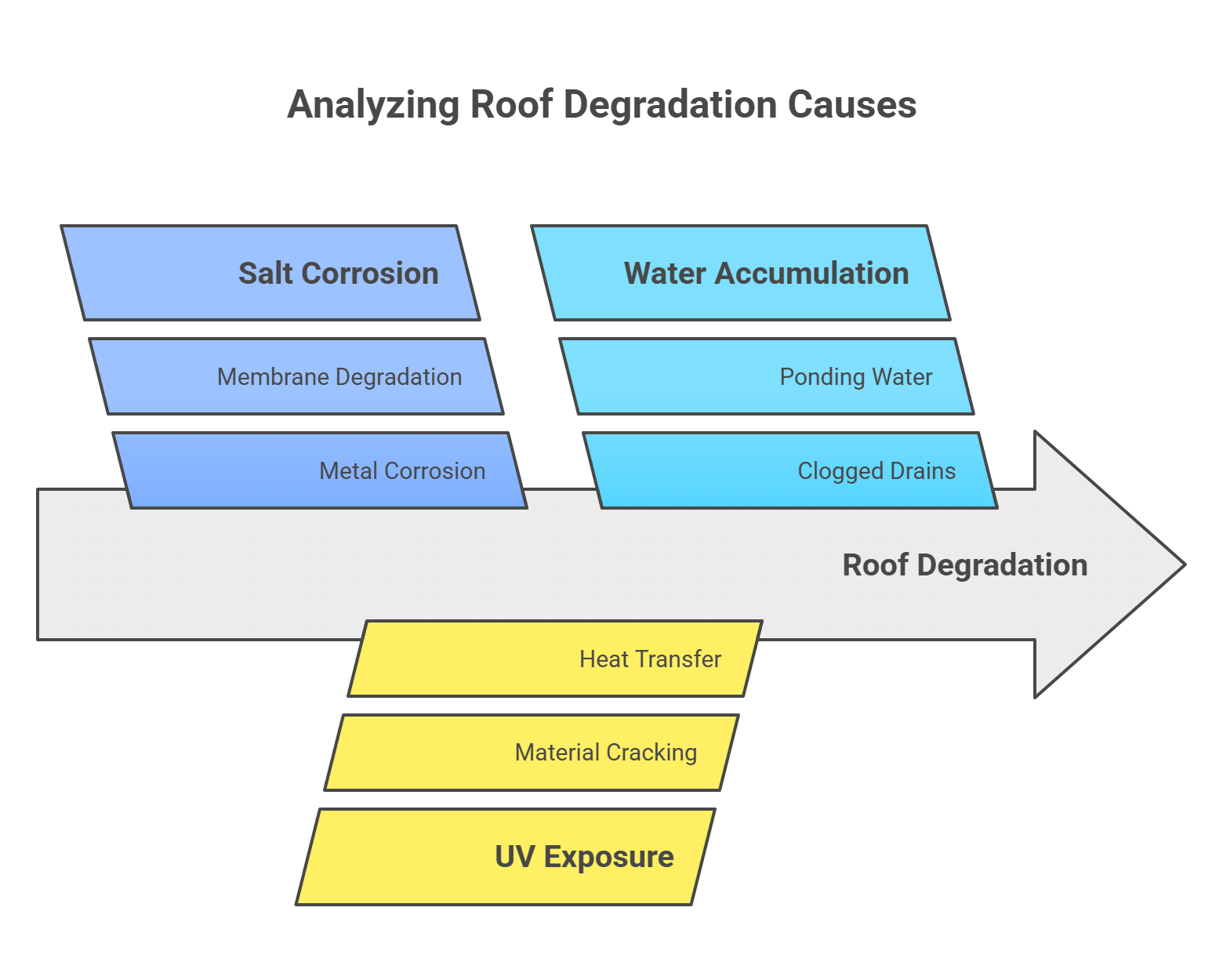
Challenge #3: Drainage & Seasonal Rain
While San Diego is known for its dry climate, the city does experience seasonal rainfalls, often arriving in concentrated bursts during winter storms or El Niño years. For commercial buildings with flat or low-slope roofs, this presents a significant challenge: if drainage is not carefully designed and maintained, even moderate rain can result in ponding water, leaks, and long-term structural damage.
Why Drainage is a Critical Issue
Unlike pitched roofs that naturally shed rainwater, most commercial roofs in San Diego are flat or nearly flat. Without proper slope and drainage, water collects in low areas and forms puddles—commonly called “ponding.” This standing water creates multiple problems:
- Accelerated Membrane Deterioration: Prolonged exposure to water weakens roofing materials, causing blistering and cracks.
- Added Weight Load: Water weighs over 8 pounds per gallon; pooling on large flat surfaces can strain roof structures, especially in older buildings.
- Mold and Mildew Growth: Standing water encourages microbial growth, which can spread into insulation and interior walls.
- Increased Leak Risk: Ponding finds its way into seams, penetrations, and vulnerable spots, creating leaks that may go unnoticed until costly damage is done.
San Diego’s Seasonal Patterns
Because rainfall in San Diego often comes in heavy bursts rather than steady showers, roofs are forced to handle large volumes of water in short periods. This sudden stress tests the efficiency of drainage systems. Commercial properties near the coast face an even tougher combination: salty air corrosion weakening drains and flashings, combined with sudden rainfall overwhelming the system.
Best Practices for Preventing Drainage Problems
- Proper Roof Design: Ensure the roof has adequate slope to direct water toward drains and scuppers. Even a slight slope can make a big difference.
- Clear Drainage Systems: Gutters, downspouts, and roof drains must be regularly cleared of debris, especially after Santa Ana winds or storm events that deposit leaves and dirt.
- Regular Inspections: Semiannual inspections—particularly before and after the rainy season—help catch problems like clogged drains or deteriorated flashings.
- Protective Coatings: In areas prone to ponding, specialized coatings can provide additional waterproofing protection.
Why It Matters for San Diego Businesses
Ignoring drainage issues can turn a single storm into a costly disaster. From damaged inventory in a warehouse to disrupted operations in an office complex, the financial impact of leaks and water damage far exceeds the cost of preventative maintenance.
By prioritizing drainage, commercial property owners in San Diego can protect their buildings, extend roof lifespan, and avoid costly emergency repairs.
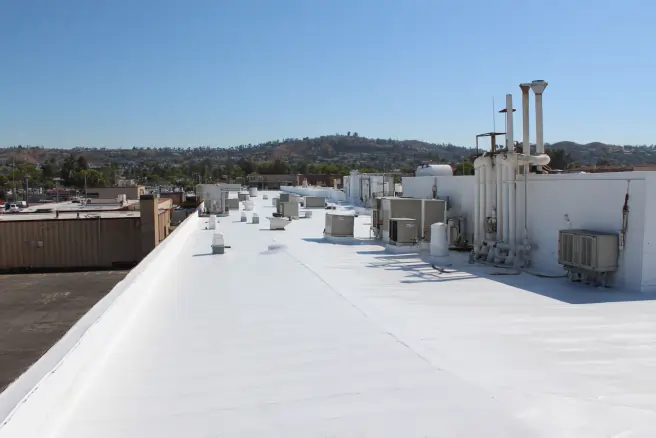
Why Proactive Maintenance is Critical in San Diego
When you combine salt air corrosion, year-round UV exposure, and seasonal rainfall, San Diego presents one of the toughest environments for commercial roofs in the United States. Each of these challenges on its own can shorten the life of a roof, but together they create a cycle of wear that quickly compounds if left unchecked. This is why proactive maintenance is not just recommended in San Diego—it’s essential.
The Cost of Reactive Repairs
Many property owners wait until leaks appear or visible damage occurs before calling a roofing contractor. Unfortunately, by that point, the problem is usually much larger—and more expensive—than it first appears. Water intrusion can damage insulation, electrical systems, and even structural components. Corrosion or UV damage that goes unnoticed for years can suddenly require a full roof replacement.
The ROI of Preventative Care
Proactive maintenance, on the other hand, extends the lifespan of a roof by years—even decades. Regular inspections catch small issues like cracked sealants, minor ponding, or early signs of corrosion before they become costly failures. Preventative care also helps maintain warranty coverage, since many manufacturers require documented inspections to keep warranties valid.
Financially, the return on investment is clear: a relatively small annual maintenance cost can save tens of thousands of dollars in premature roof replacement or interior repairs. Businesses also benefit from avoiding operational disruptions caused by emergency leaks or repairs.
Local Expertise Matters
In San Diego, it’s not enough to have a general roofing plan—property owners need a San Diego contractor who understands the local environment. The right partner will know how coastal winds carry salt inland, how summer UV accelerates wear, and how seasonal storms test drainage systems. With tailored maintenance plans, business owners can feel confident their roof is prepared for all three challenges unique to the region.
A Smart Long-Term Strategy
Ultimately, proactive maintenance is about protecting your investment. For San Diego businesses, this means lower long-term costs, improved building performance, and peace of mind knowing that your roof is ready for whatever nature throws its way.
Looking Ahead: Emerging Technologies That Could Revolutionize Coastal Roofing
While today’s best practices focus on material durability and scheduled inspections, the future of coastal roofing is entering a new frontier—powered by sensors, automation, and sustainable innovation. For San Diego property owners, adopting these cutting-edge technologies could offer a competitive edge in longevity, energy efficiency, and cost savings.
1. Smart Roofing Sensors and IoT Integration
New sensor-based systems can monitor moisture levels, membrane tension, UV exposure, and even salt accumulation in real time. These Internet of Things (IoT) devices send alerts directly to building management systems or smartphones, enabling property managers to address small issues before they escalate into costly repairs.
Example: A smart sensor detects pooling water on a flat roof and alerts maintenance staff within minutes—preventing mold growth or ceiling collapse during a storm.
2. Self-Healing Roofing Membranes
Advanced materials, like polymeric self-healing membranes, are being tested in marine environments. These materials contain embedded capsules of sealant that activate when cracks or tears form, automatically patching small punctures caused by UV or salt degradation.
This kind of innovation could dramatically reduce lifecycle maintenance costs and extend roof life in coastal environments by 30% or more.
3. Energy-Producing Roof Systems
As solar technologies become lighter and more flexible, integrated photovoltaic membranes (also known as solar roofing skins) are becoming viable for flat and low-slope roofs. In San Diego’s sunny climate, this can turn your roofing system into a revenue-generating asset that not only protects but also powers your building.
Bonus Insight: Pairing reflective “cool roof” membranes with integrated solar skins could offer dual benefits—lower cooling costs and energy generation.
4. AI-Powered Roof Lifecycle Modeling
Advanced software now uses machine learning models to predict roof wear based on hyper-local data such as wind speeds, salt concentration, and solar exposure. This allows businesses to plan maintenance with surgical precision—maximizing budget efficiency and warranty utilization.
Instead of reacting to leaks, businesses can now schedule replacements or coatings at the exact moment they provide the most ROI.
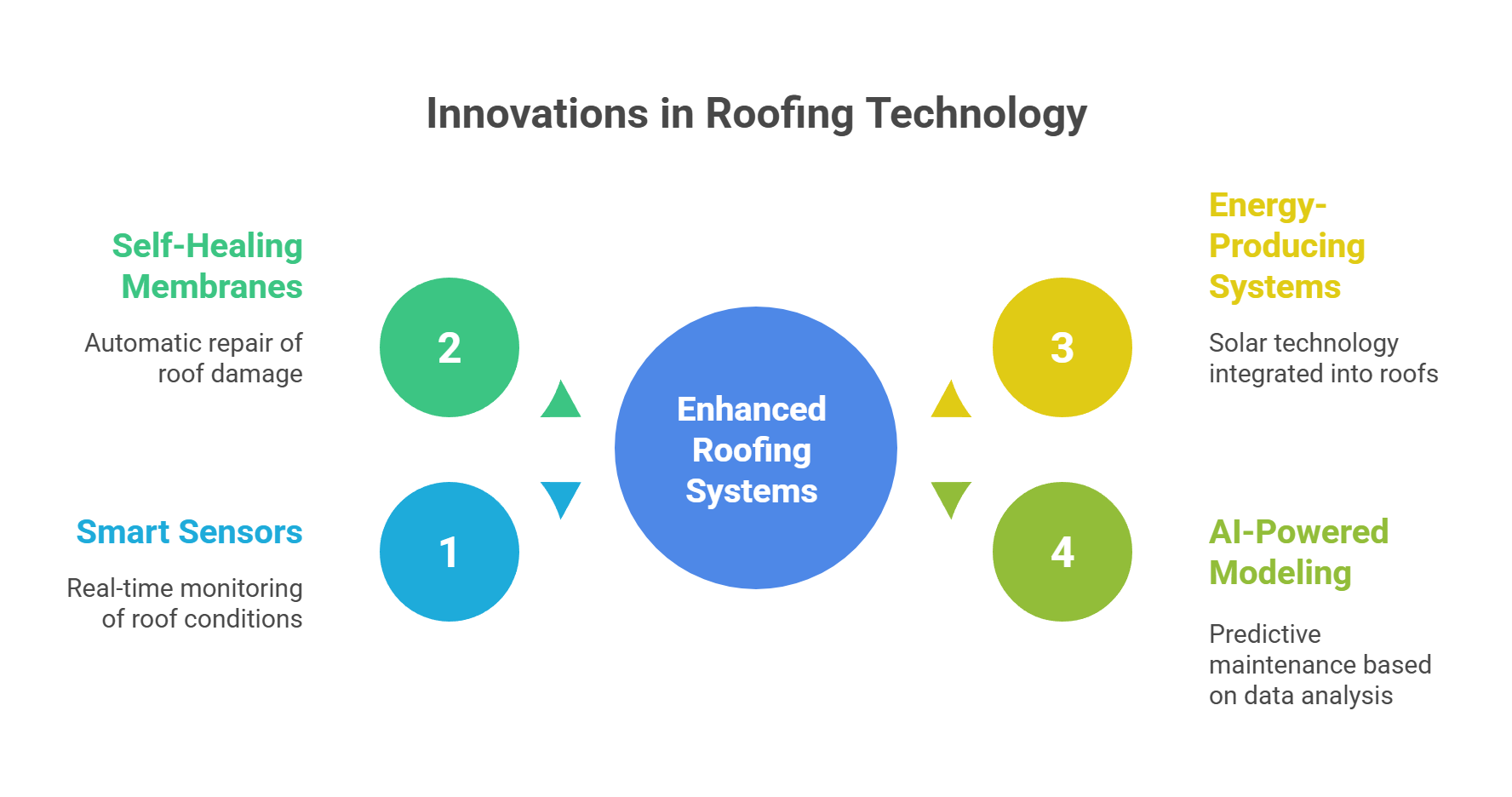
Why San Diego Businesses Should Future-Proof Now
Waiting until these technologies are mainstream may mean missing out on early adopter advantages such as reduced insurance premiums, green building certifications, or government rebates. Forward-thinking business owners who integrate smart materials and predictive analytics into their roofing systems position themselves for a more resilient, energy-efficient, and cost-effective future.
Protect Your San Diego Commercial Roof Today
San Diego’s coastal environment is beautiful, but it takes a heavy toll on commercial roofs. Salt air corrosion, relentless UV exposure, and seasonal rain all work together to shorten roof lifespans and increase repair costs if they’re not managed properly. The good news is that with the right materials, regular inspections, and a proactive maintenance plan, you can protect your property and avoid unexpected expenses.
At SW Commercial Roofing, we’ve spent more than two decades helping San Diego businesses safeguard their buildings against these exact challenges. Whether you need an inspection, repair, or a long-term roofing solution, our team is here to help.
Contact us today to schedule your free inspection and protect your roof from San Diego’s toughest conditions.

